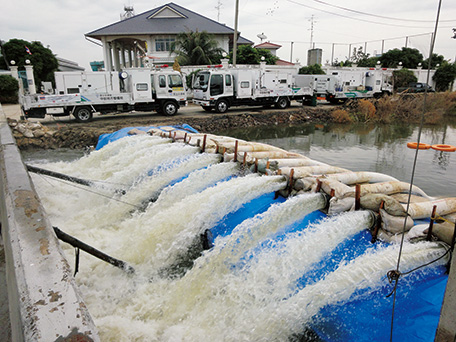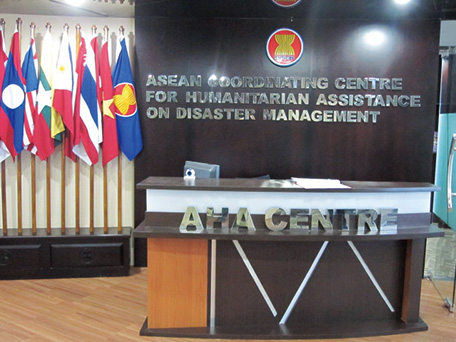Japan's Official Development Assistance White Paper 2012
Chapter 2 Disaster Risk Reduction Cooperation in Practice

Japanese drain pump vehicles that played a major role after the Thai floods. (Photo: JICA)
Section 1 Cooperation with ASEAN
A crucial pillar of Japan's international cooperation can be said to be in building resilient societies able to cope adequately with natural disasters, which nullify development efforts in an instant, and also to that end, in promoting mainstreaming disaster risk reduction among the policies of each nation. Therein it is particularly important to mainstream disaster risk reduction activities in Asia as the region is said to account for over 90% of the fatalities and victims occurring due to natural disasters worldwide.
Japan ranks cooperation within the domain of disaster risk reduction as one of the most critical issues within ASEAN-Japan cooperation, and has provided various assistance to date. In particular, based on the prompt and plentiful assistance Japan received from ASEAN member states in the aftermath of the Great East Japan Earthquake in March 2011, Japan intends to step up its future cooperation with ASEAN member states in the area of disaster risk reduction.
In the ASEAN Post Ministerial Conference +1 session with Japan in July 2011, Japan proposed the "Disaster Management Network for the ASEAN Region." This initiative aims to fully utilize the disaster risk reduction knowledge acquired through the Great East Japan Earthquake, the Great Hanshin Earthquake and the Sumatra Earthquake, etc. as well as Japan's advanced approaches in the area of disaster risk reduction and the environment in the ASEAN region. In light of the widespread damage from the earthquake and tsunami that became clear after the Sumatra Earthquake, and the widening damage range of typhoons that are increasing in severity and occurrence due to climate change, the aim is to construct a disaster risk reduction network that perceives the ASEAN region as a whole. More specifically, in addition to assisting with the strengthening of the AHA Centre's capabilities, (the ASEAN Coordinating Centre for Humanitarian Assistance on Disaster Management), Japan is also conducting bilateral aid with each ASEAN member state. Likewise, through sharing knowledge, experience and information for disaster countermeasures, Japan is also implementing approaches to strengthen the network "from outer space to rural communities."

AHA Centre (Photo: AHA Centre)
The AHA Centre was established in Jakarta, Indonesia with the conclusion of its establishment agreement in the 19th ASEAN Summit in November 2011. It is envisaged that the AHA Centre functions as a hub of disaster management for the ASEAN region, and that in peacetime, it assesses the risks in times of disasters within the ASEAN region, continually monitors the situation within the ASEAN region, and in the event of a disaster, will share information on the disaster with ASEAN member states and play a key role in coordinating emergency responses.
As for Japan, through utilization of the Japan-ASEAN Integration Fund (JAIF), as the project to "Establishment of an Integrated Information and Communication Technology System to Strengthen the Operation of AHA Centre," Japan introduced communications equipment to the AHA Centre to upgrade the risk identification and monitoring functions that the center oversees, and has dispatched one ICT expert since November 2011. Likewise, as the "Establishment of a Disaster Emergency Logistic System for ASEAN" project, Japan is also assisting with the construction of a system to provide stockpiled emergency supplies and to manage and transport these supplies, in order to respond to disasters promptly and effectively. Japan is also assisting with the management side of the AHA Centre so that the Centre can function adequately as a regional hub of disaster management. Furthermore, in August 2012, disaster risk reduction related personnel from the AHA Centre and each ASEAN member state were invited to Japan and workshops were held to share knowledge on disaster risk reduction.
As bilateral aid with ASEAN member states, as well as technical cooperation such as dispatching experts and training, Japan is providing various assistance in disaster risk reduction measures such as the ODA loan "Project for Disaster and Climate Change Countermeasures Using Earth Observation Satellites (Phase 1)" to Viet Nam. Similarly, as a wide-ranging move that encompasses multiple countries, the AHA Centre and ASEAN member states will in future use satellite information, improve the capabilities of industrial complexes in the region to cope with disasters, and will provide assistance to share the results with the entire region.

Member of the AHA Centre staff monitoring disaster information. Through the Japan-ASEAN Integration Fund (JAIF) Japan provided ICT equipment at the AHA Centre. (Photo: AHA Centre)
